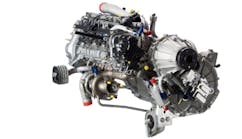GE Aerospace, Boeing, and NASA Collaborate to Study Open Fan Engine Design for Efficient Future Flight
A new project led by GE Aerospace (NYSE: GE), with collaboration from Boeing, NASA, and Oak Ridge National Laboratory will model the integration of an Open Fan engine design with an airplane, supporting the aviation industry’s efforts to develop more energy efficient technology.
The U.S. Department of Energy announced that the effort has been awarded 840,000 supercomputing hours through its INCITE program. INCITE is a highly competitive program that supports the world’s most computationally intensive projects.
GE Aerospace engineers have previously used exascale computing to model the performance and noise levels of Open Fan engine components. Open Fan architecture is a new design of jet engines that removes the traditional casing, allowing for a larger fan size with less drag to improve fuel efficiency.
Now, engineers will be able to study the aerodynamics of an Open Fan mounted on an aircraft wing in simulated flight conditions. This allows the engine design to be optimized for additional efficiency, noise, and other performance benefits.
Replicating a full-size integrated engine and airplane in the design phase would be impossible without the computational power of the newest supercomputing machines.
“Advanced supercomputing capability is a key breakthrough enabling the revolutionary Open Fan engine design. Airplane integration is critical. Today’s announcement with Boeing, NASA, and Oak Ridge National Laboratory to simulate the latest airplane and engine designs continues a longstanding legacy of world-leading innovation in the aviation industry,” said Arjan Hegeman, general manager for future of flight technology at GE Aerospace.
The team will have access to the Aurora supercomputer at Argonne National Laboratory, and to the Frontier supercomputer at Oak Ridge National Laboratory. Frontier and Aurora are the world’s second and third fastest supercomputers, both capable of crunching data at more than a quintillion calculations per second.
CFM RISE program
Open Fan is one of a suite of technologies being advanced through CFM International’s Revolutionary Innovation for Sustainable Engines (RISE)* program. Unveiled in 2021, the CFM RISE program is one of the aviation industry’s most comprehensive technology demonstrators showing real progress with more than 250 tests completed.
Through the RISE program, CFM is developing advanced engine architectures like Open Fan, compact core and hybrid electric systems to be compatible with 100% or unblended Sustainable Aviation Fuel (SAF). The CFM RISE program targets more than 20% better fuel efficiency with 20% lower CO2 emissions compared to the most efficient commercial engines in service today.
“We aim to do something our company has never achieved before — introduce a new jet engine that is 20 percent more fuel efficient than our most advanced commercial engines today. This represents a jump in technology development that usually takes multiple generations to achieve. Supercomputing helps make it possible,” Hegeman said.
GE Aerospace plans to hire more than 900 engineers in 2024, reflecting its continued focus on innovation to support current aircraft engine programs and develop new technologies for the future of flight. View job openings at invent.ge/engineering.
*RISE is a registered trademark of CFM International, a 50-50 joint company between GE Aerospace and Safran Aircraft Engines.




